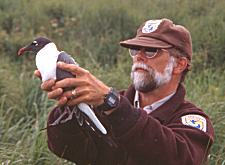

Common Tern
Seabird restoration techniques developed in Maine are now being used globally to help restore short-tailed albatross colonies in Japan, dark-rumped petrels in Ecuador and with common murres in California.

Razorbill
Seabird Conservation
The mission of the Friends of Maine Seabird Islands is to encourage conservation and appreciation of seabirds, their nesting and coastal habitats, and to support the Maine Coastal Islands National Wildlife Refuge. History Seabirds have always relied on
Maine's coastal islands as places for laying eggs and raising their young.
Generally, the islands used by seabirds are small, unforested, rocky islands that provide a setting free of
mammalian predators such as foxes, mink and raccoons. Flying
distance from the mainland often discourages avian predators such
as great horned owls. The cold waters surrounding the islands
hold an abundant supply of fish and invertebrates for seabirds to eat.
Europeans began settling the islands
in the 1600s. In the late
1800s, the fashion industry posed an additional threat to the
birds' existence. Women's hats were decorated with feathers.
Egrets, herons, and terns were especially popular and, therefore,
were the species most harmed by the trend (read more about this...). At the
start of the 20th Century, most seabirds in the Gulf of Maine
were on the brink of extirpation. Some seabird species, nearly eradicated in Maine by the end of the 19th century, have recovered dramatically, thanks to to the passage of state and federal conservation laws, island acquisition, habitat protection, and the restoration efforts of dedicated biologists. Many threats remain. Continuing loss of nesting habitat, increasing nesting and habitat disturbance from recreational activities, growing coastal real estate development pressure and competition from expanding gull populations all cause stress in seabird habitats.
In fact, some seabird species nesting in Maine are no longer able to survive without direct human intervention. Biologists have been working since the mid-1970s to reintroduce and restore terns and puffins to former nesting islands along the Maine coast. Their successful efforts have also benefited nesting populations of laughing gulls, black guillemots, razorbills, Leach's storm petrels and common eiders. Ultimately, stewardship of natural resources is a community responsibility. The next phase in the conservation of Maine seabirds will require support from an informed public. The Friends of Maine Seabird Islands are dedicated to informing and educating Maine's one million residents and six million coastal visitors about the needs of the seabirds.
|
| Friends of Maine Seabird Islands c/o Maine Coastal Islands National Wildlife Refuge PO Box 232 Rockport, ME 04856 (207) 236-6970 [email protected] Jane Hopwood, Chair |


